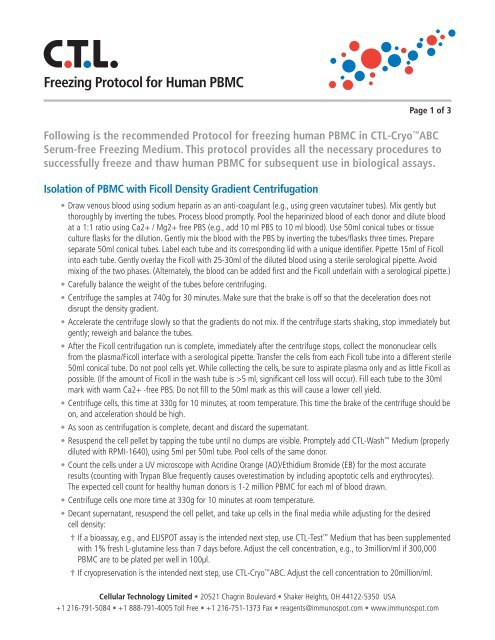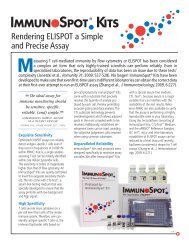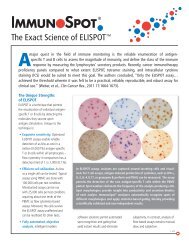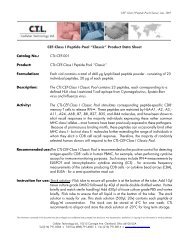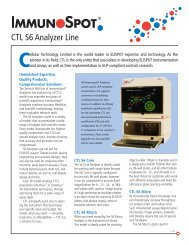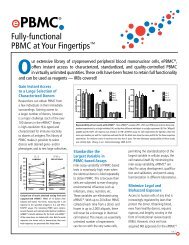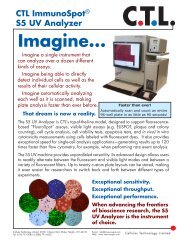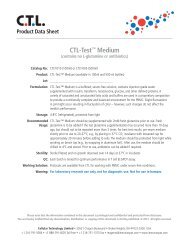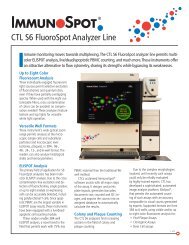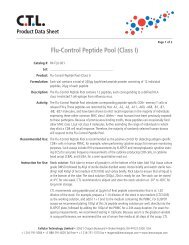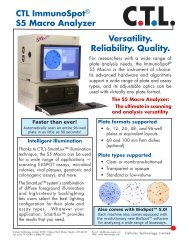Freezing Protocol for Human PBMC - Cellular Technology, Ltd
Freezing Protocol for Human PBMC - Cellular Technology, Ltd
Freezing Protocol for Human PBMC - Cellular Technology, Ltd
You also want an ePaper? Increase the reach of your titles
YUMPU automatically turns print PDFs into web optimized ePapers that Google loves.
<strong>Freezing</strong> <strong>Protocol</strong> <strong>for</strong> <strong>Human</strong> <strong>PBMC</strong><br />
Page 1 of 3<br />
Following is the recommended <strong>Protocol</strong> <strong>for</strong> freezing human <strong>PBMC</strong> in CTL-Cryo ABC<br />
Serum-free <strong>Freezing</strong> Medium. This protocol provides all the necessary procedures to<br />
successfully freeze and thaw human <strong>PBMC</strong> <strong>for</strong> subsequent use in biological assays.<br />
Isolation of <strong>PBMC</strong> with Ficoll Density Gradient Centrifugation<br />
• Draw venous blood using sodium heparin as an anti-coagulant (e.g., using green vacutainer tubes). Mix gently but<br />
thoroughly by inverting the tubes. Process blood promptly. Pool the heparinized blood of each donor and dilute blood<br />
at a 1:1 ratio using Ca2+ / Mg2+ free PBS (e.g., add 10 ml PBS to 10 ml blood). Use 50ml conical tubes or tissue<br />
culture flasks <strong>for</strong> the dilution. Gently mix the blood with the PBS by inverting the tubes/flasks three times. Prepare<br />
separate 50ml conical tubes. Label each tube and its corresponding lid with a unique identifier. Pipette 15ml of Ficoll<br />
into each tube. Gently overlay the Ficoll with 25-30ml of the diluted blood using a sterile serological pipette. Avoid<br />
mixing of the two phases. (Alternately, the blood can be added first and the Ficoll underlain with a serological pipette.)<br />
• Carefully balance the weight of the tubes be<strong>for</strong>e centrifuging.<br />
• Centrifuge the samples at 740g <strong>for</strong> 30 minutes. Make sure that the brake is off so that the deceleration does not<br />
disrupt the density gradient.<br />
• Accelerate the centrifuge slowly so that the gradients do not mix. If the centrifuge starts shaking, stop immediately but<br />
gently; reweigh and balance the tubes.<br />
• After the Ficoll centrifugation run is complete, immediately after the centrifuge stops, collect the mononuclear cells<br />
from the plasma/Ficoll interface with a serological pipette. Transfer the cells from each Ficoll tube into a different sterile<br />
50ml conical tube. Do not pool cells yet. While collecting the cells, be sure to aspirate plasma only and as little Ficoll as<br />
possible. (If the amount of Ficoll in the wash tube is >5 ml, significant cell loss will occur). Fill each tube to the 30ml<br />
mark with warm Ca2+ -free PBS. Do not fill to the 50ml mark as this will cause a lower cell yield.<br />
• Centrifuge cells, this time at 330g <strong>for</strong> 10 minutes, at room temperature. This time the brake of the centrifuge should be<br />
on, and acceleration should be high.<br />
• As soon as centrifugation is complete, decant and discard the supernatant.<br />
• Resuspend the cell pellet by tapping the tube until no clumps are visible. Promptely add CTL-Wash Medium (properly<br />
diluted with RPMI-1640), using 5ml per 50ml tube. Pool cells of the same donor.<br />
• Count the cells under a UV microscope with Acridine Orange (AO)/Ethidium Bromide (EB) <strong>for</strong> the most accurate<br />
results (counting with Trypan Blue frequently causes overestimation by including apoptotic cells and erythrocytes).<br />
The expected cell count <strong>for</strong> healthy human donors is 1-2 million <strong>PBMC</strong> <strong>for</strong> each ml of blood drawn.<br />
• Centrifuge cells one more time at 330g <strong>for</strong> 10 minutes at room temperature.<br />
• Decant supernatant, resuspend the cell pellet, and take up cells in the final media while adjusting <strong>for</strong> the desired<br />
cell density:<br />
† If a bioassay, e.g., and ELISPOT assay is the intended next step, use CTL-Test Medium that has been supplemented<br />
with 1% fresh L-glutamine less than 7 days be<strong>for</strong>e. Adjust the cell concentration, e.g., to 3million/ml if 300,000<br />
<strong>PBMC</strong> are to be plated per well in 100μl.<br />
† If cryopreservation is the intended next step, use CTL-CryoABC. Adjust the cell concentration to 20million/ml.<br />
<strong>Cellular</strong> <strong>Technology</strong> Limited • 20521 Chagrin Boulevard • Shaker Heights, OH 44122-5350 USA<br />
+1 216-791-5084 • +1 888-791-4005 Toll Free • +1 216-751-1373 Fax • reagents@immunospot.com • www.immunospot.com
<strong>Freezing</strong> <strong>Protocol</strong> <strong>for</strong> <strong>Human</strong> <strong>PBMC</strong><br />
Cryopreservation of <strong>PBMC</strong><br />
In preparation of freezing (it is advisable to start with these preparations while the Ficoll gradient runs):<br />
• Mix CTL-Cryo A with CTL-Cryo B in an 80%-20% (v/v) ratio (4+1) by slowly adding CTL-Cryo B into CTL-Cryo A<br />
(CTL-Cryo B contains DMSO as a component, please refer to MSDS at the end of protocol). Sterile-filter the solution<br />
(0.2µm filter).<br />
• Label 1.8ml cryotubes. The number of tubes can be estimated from the anticipated cell yield (1-2million <strong>PBMC</strong> per ml<br />
blood drawn) when freezing 10million <strong>PBMC</strong> per vial. <strong>Freezing</strong> more cells per vial may lead to cell loss.<br />
After Washing of <strong>PBMC</strong>:<br />
Page 2 of 3<br />
• The <strong>PBMC</strong> have been resuspended in CTL- Cryo C medium at 20 million cells per ml (see above).<br />
• Slowly, over a time period of ~2 min, add an equal volume of CTL-CryoAB mixture prepared as specified above):<br />
gently swirl the tube to permit complete mixing of the two media while the concentration of CTL-CryoAB slowly<br />
increases.<br />
• Aliquot the <strong>PBMC</strong> suspension into the pre-labeled cryovials: 1ml into each 1.8 ml vial.<br />
• Place cryovials into Nalgene cryofreezing container, ‘Mr. Frosty’ filled with 2-propanol. The container should be at<br />
room temperature.<br />
† If Nalgene cryofreezing containers are not available, the following “low technology” method works equally well:<br />
» Place the cryovials in a Styrofoam rack (e.g., racks in which the 15ml conical tubes are sold).<br />
» Place a second Styrofoam container of the same type over the first one and tape the two containers together.<br />
» Insert into a plastic bag leaving some air in the bag be<strong>for</strong>e taping it closed.<br />
• Transfer the cryofreezing container (or bagged Styrofoam rack) into a -80°C freezer <strong>for</strong> a minimum of 12 hours. After<br />
a minimum of 12 hours, transfer the cryovials into liquid nitrogen tanks <strong>for</strong> indefinite storage. Extended storage at<br />
-80 °C will eventually result in decreased viability and recovery; there<strong>for</strong>e, transferring to liquid nitrogen within 2 days<br />
is recommended.<br />
Please note that the in<strong>for</strong>mation contained in this document is privileged and confidential and protected from disclosure.<br />
You are hereby notified that any dissemination, distribution, or copying of this document is strictly prohibited. © 2012. All rights reserved.<br />
<strong>Cellular</strong> <strong>Technology</strong> Limited • 20521 Chagrin Boulevard • Shaker Heights, OH 44122-5350 USA<br />
+1 216-791-5084 • +1 888-791-4005 Toll Free • +1 216-751-1373 Fax • reagents@immunospot.com • www.immunospot.com
Equipment and Reagents<br />
EquIPMEnT: VEnDoR: CATALoG nuMBER:<br />
Conical Tubes, 50ml, sterile Fisher 14-432-22<br />
Serological Pipette, 2ml Fisher 13-678-11C<br />
Serological Pipette, 5ml Fisher 13-678-11D<br />
Serological Pipette, 10ml Fisher 13-678-11E<br />
Pipette Aids, Drummond Fisher 13-681-19<br />
Centrifuge, Allegra 6R Beckman Rotor Gh3.8A ALR6<br />
Variety MicroPipette (20µl) Eppendorf 21-371-6<br />
Pipette Tips (200µl) VWR 53508-783<br />
Gloves Fisher 19-048-575A<br />
Hemocytometer Reichert Bright-Line 02-671-5<br />
Hematology Mixer Barnstead/Thermolyne 2-814-2<br />
Vials, cryogenic, 1.8ml, sterile Nalgene 12-565171N<br />
Nalgene Cryo <strong>Freezing</strong> Container Nalgene 15350-50<br />
-80° Freezer Forma Scientific Inc. 55703-430<br />
Liquid Nitrogen Storage Tank Thermo Forma 8030<br />
Biological Safety Cabinet Forma Scientific Inc. Model 1286<br />
REAGEnTS: VEnDoR: CATALoG nuMBER:<br />
Whole blood Subject Source<br />
Lymphoprep Greiner/Matrix 1114545<br />
PBS sterile, Ca2+, Mg2+ free Cellgro 45000-436<br />
Acridine orange (10mg/ml)* Fisher #A3568<br />
Ethidium Bromide (1%) Fisher Biotech BP1302-10<br />
CTL-Wash Supplement 10x <strong>Cellular</strong> <strong>Technology</strong> Limited, USA CTLW-010<br />
CTL-Test Medium, 500ml <strong>Cellular</strong> <strong>Technology</strong> Limited, USA CTLT-005<br />
CTL-Cryo ABC <strong>Freezing</strong> Kit <strong>Cellular</strong> <strong>Technology</strong> Limited, USA CTLC-ABC<br />
RPMI-1640 Fisher Biotech BW12-167Q<br />
Page 3 of 3<br />
Please note that the in<strong>for</strong>mation contained in this document is privileged and confidential and protected from disclosure.<br />
You are hereby notified that any dissemination, distribution, or copying of this document is strictly prohibited. © 2012. All rights reserved.<br />
<strong>Cellular</strong> <strong>Technology</strong> Limited • 20521 Chagrin Boulevard • Shaker Heights, OH 44122-5350 USA<br />
+1 216-791-5084 • +1 888-791-4005 Toll Free • +1 216-751-1373 Fax • reagents@immunospot.com • www.immunospot.com


